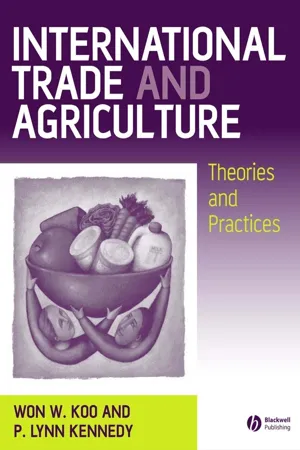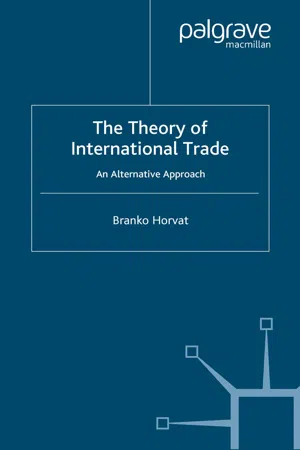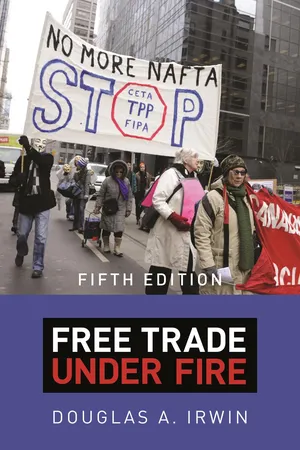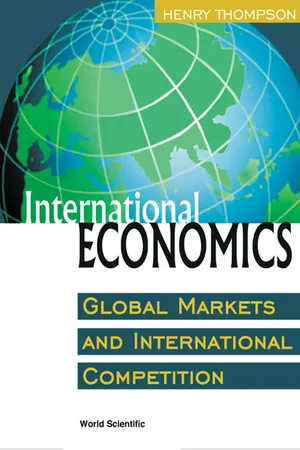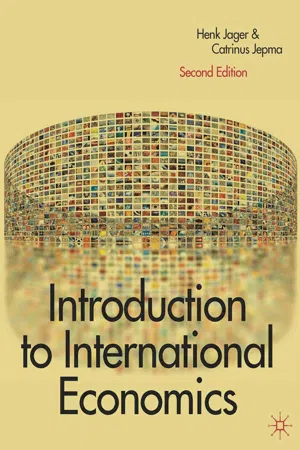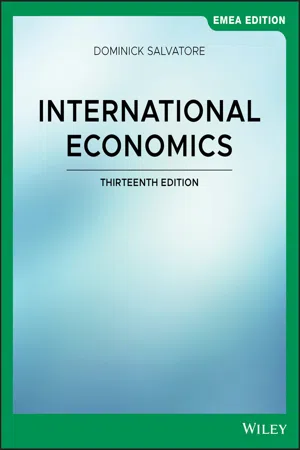Economics
Benefits of Tariffs
Tariffs can protect domestic industries from foreign competition by making imported goods more expensive. This can help preserve jobs and prevent the loss of domestic industries. Additionally, tariffs can generate revenue for the government, which can be used for various public services and infrastructure projects.
Written by Perlego with AI-assistance
Related key terms
1 of 5
9 Key excerpts on "Benefits of Tariffs"
- eBook - PDF
- Dominick Salvatore(Author)
- 2012(Publication Date)
- Wiley(Publisher)
Section 5.4 shows the effects of a tariff on consumer and producer surplus, while Section 5.5 measures the costs and benefits of a tariff in the nation. Section 5.6 measures the costs and benefits of a tariff in a large nation, while Section 5.7 discusses the size of an optimum tariff and foreign retaliation. Finally, Section 5.8 examines the theory of tariff structure. The optional appendix Chapter Five Trade Restrictions: Tariffs 117 to this chapter presents a more advanced analysis of a tariff using offer curves. 5.2 TYPES OF TARIFFS Since the restrictions and regulations that a nation imposes on international Trade or commercial policies The regu- lations governing a nation’s commerce or international trade. trade deal with the nation’s trade or commerce, they are generally known as trade or commercial policies. We will see that although trade restrictions are invariably rationalized in terms of national welfare, in reality they are usually advocated by those special groups in the nation that stand to benefit from such restrictions. The tariff has been the most important type of trade restriction Import tariff A tax or duty on imports. Export tariff A tax or duty on exports. Ad valorem tariff A tariff expressed as a fixed percentage of the value of a traded commodity. Specific tariff A tariff expressed as a fixed sum per unit of a traded commodity. Compound tariff A combination of an ad valorem and a specific tariff. historically. A tariff is a tax or duty levied on the traded commodity as it crosses a national boundary. An import tariff is a duty on the imported commodity, while an export tariff is a duty on the exported commodity. Import tariffs are more important than export tariffs, and most of our discussion will deal with import tariffs. - eBook - ePub
- W. Charles Sawyer, Richard L. Sprinkle(Authors)
- 2020(Publication Date)
- Routledge(Publisher)
On the import side of the market, the gains are diffused among thousands or even millions of consumers. The fact that greater imports are saving consumers (through lower prices) money on their purchases of cloth often goes unrecognized. The large gains to consumers in total come from relatively small gains over a very large number of purchases. The gains from trade are large in total, but the gains for any particular item frequently are small. Although the gains are diffused among consumers, the losses to producers and workers are concentrated. For example, firms in an industry that competes with imports face lower or even negative profits or in the extreme case, bankruptcy. Workers in such an industry may see wage increases that are lower because of competition from imports. If the import competition is large enough, the workers may experience reduced hours or even loss of employment. Given these losses, it is asking a lot for the industry to calmly accept this as the price paid for the greater economic good.THE ECONOMIC EFFECTS OF TARIFFSTo analyze a tariff’s economic impact, we need to separate the effects that a tariff has on consumers from the effects it has on domestic producers. To separate these effects, we can use the concepts of producer and consumer surplus developed above. The central point of the analysis is that there is a net loss to a country’s welfare that results from putting a tariff on imported goods.The effects of a tariff for a small countryNow, let us use the concepts of consumer and producer surplus that we just developed to analyze the impact of a tariff. We begin our analysis by considering the case of a country whose imports constitute a very small portion of total world imports. The importing country is referred to as a price taker because it is so small that it cannot influence world market conditions. In Figure 8.4 the domestic demand and supply of cloth is illustrated. Before international trade, equilibrium in the domestic cloth market occurs at point E. The equilibrium price and quantity of cloth associated with this point are P and Q, respectively.FIGURE 8.4Domestic effects of a tariffThe tariff placed on imported cloth raises the price of cloth from Pw to Pt. As a result of the price increase, consumer surplus declines and producer surplus expands. The country’s welfare falls by the amount equal to the production effect—triangle b—and the consumption effect—triangle d. - eBook - PDF
International Trade and Agriculture
Theories and Practices
- Won W. Koo, P. Lynn Kennedy(Authors)
- 2008(Publication Date)
- Wiley-Blackwell(Publisher)
In addition to this net welfare loss, the tariff shifts income from consumers to the government and the producers of the protected commodity. The tariff may stimulate growth in the protected industry at a cost paid by consumers. For example, the US steel industry clearly benefits from the high price of steel resulting from a tariff on imported steel. On the other hand, American consumers must pay higher prices on pro- ducts using steel, such as automobiles and machinery, implying that consumers are worse off under the government protection of the steel industry. A tariff increases .- m 2 70 60 50 45 40 30 20 10 0 Quantity I ' I ' I ' I ' 0) : : 10 20 30 Quantity Figure 7.6 The welfare effects of a tariff a small-country case. U Y V Y - - - - - Y Y + TRADE RESTRICTIONS: TARIFFS - p - m - - - - _ - - the degree of market power for the protected industry in the country, thereby lowering productive efficiency and penalizing consumers. W 7.5 OPTIMAL TARIFF POLICY Before imposing an import tariff, the world equilibrium is obtained at point E where ES intersects ED in Figure 7.7(b). The quantity traded is 20 units at the world equi- librium price of $40 per unit. If an importing country imposes an import tariff of $15 per unit on a commodity, it is represented by vertical distance ab between ED and ES. The price of the commodity in the importing country rises from $40 per unit to $45 per unit, and the price in the exporting country declines from $40 per unit to $30 per unit, as shown in Figure 7.7. In this case, the total tax revenue collected by the government is equal to area C + E (or C' + E'). This tax revenue is divided into two parts: area C (or C') paid by consumers in the importing country and area E (or E') paid by producers in the exporting country. The net loss in social welfare in the importing country is area B + D, which is also equal to area G, as discussed in the previous section, and the net loss in the export- ing country is area H. - eBook - PDF
The Theory of International Trade
An Alternative Approach
- B. Horvat(Author)
- 2016(Publication Date)
- Palgrave Macmillan(Publisher)
Reduced import – production plus con- sumption effects – improves balance of trade, saves foreign exchange and contributes to economic independence. Tariffs may also be used to increase military preparedness or as a bargaining instrument. If a large country imposes tariffs, it will change international prices and thus change terms of trade. Countries whose competitiveness is deteriorating move towards increased protectionism (as Great Britain did after the First World War). Tariff represents an import tax whereby the lower international price of importables is equalized with the domestic price p m (1 t)P m Similarly an export tax reduces domestic price of exportables p e (1 t) P e where m stands for importables and e for exportables. Already Abba Lerner (1934) noticed that a general export tax has the same effect as a general import tax, ceteris paribus. The ratio of domestic prices remains the same p e 1 P e , p m P m (1 t) or p e (1 t) P e (18.1) p m 1 t P m (the conclusion is not valid when non-traded goods are included). The imposition of export tax reduces domestic export prices but leaves intact import prices. That may also be interpreted as un- changed domestic export prices and increased import prices. In the short run an export tax operates in a depressive way (for exportables) and tariff in an expansionary way (for import substitutes). The lat- ter seems preferable for policy purposes. Tariffs and Subsidies 127 18.2 PROHIBITIVE TARIFF AND SUBSIDY A tariff that stops imports is called prohibitive. Imports will be stopped when the ratio of home prices is equalized with the ratio of world prices with tariffs p 1 / p 2 (1 t)P 1 / P 2 (18.2) Tariff rate t is prohibitive. Lower than that is insufficient because X 1 will continue to be imported. A higher rate is not necessary. That would mean pure revenue collecting for the government and there are more efficient instruments for that purpose (for instance, value added tax). - eBook - ePub
Free Trade under Fire
Fifth Edition
- Douglas A. Irwin(Author)
- 2020(Publication Date)
- Princeton University Press(Publisher)
These anti-import policies reduce trade and tend to distort economic activity, leading to inefficient outcomes (in the absence of offsetting effects). Economists tend to focus on two effects of tariffs and other policies. First, import barriers redistribute income from domestic consumers to domestic producers. When imports of a product are restricted, the product becomes scarcer in the domestic market. Scarcity drives up the price, benefiting domestic producers of the product but harming consumers who are forced to pay more for it.Second, protectionist policies distort domestic prices in a way that leads to inefficiency (wasted resources), or in economic jargon, a deadweight loss. As import restrictions push the domestic price of a good above the world price, domestic firms produce more (at a higher cost than the goods would be available on the world market), while consumers buy less than they otherwise would, forgoing some of the benefits of consumption. The inefficiency associated with these distortions of incentives imposes a deadweight loss on the overall economy. Trade barriers are like an income transfer in which ten dollars is taken from consumers while giving only eight dollars to producers, resulting in a two-dollar loss to the economy as a whole.In 2018, President Trump, who calls himself “Tariff Man,” unleashed successive waves of tariffs. The first wave saw the imposition of 30 percent duties on imported solar panels and 20 to 50 percent on imported washing machines. The second wave included a 25 percent tariff on steel imports and a 10 percent tariff on aluminum imports. The third wave targeted imports from China, 25 percent tariffs on $34 billion of imports in July, 25 percent tariffs on an addition $16 billion in imports in August, and 10 percent tariffs on another $200 billion in imports in September. (This was followed by plans, in December 2019, by another $300 billion in imports from China being taxed at 10 percent, unless a truce was reached.)One study of these tariffs confirmed that the demand for imports is downward sloping in that higher tariffs reduce imports: A 1 percentage point increase in the tariff rate gives rise to a 6 percentage point fall in imported quantity. The researchers also found that the tariffs were fully passed through to domestic consumers of those goods. (There was some question whether foreign exporters would absorb some of the tax in the prices they charge in the U.S. market.) The total cost to consumers was $52.8 billion, or $414 per household, some of which was transferred to domestic producers. Payments to the government in tariff revenue was $36 billion. Taking the consumer cost and subtracting transfers to producers and the government, the cumulative deadweight loss through November 2018 was $6.9 billion. If the tariffs remain in place, the costs for 2019 and future years would be higher than this because the tariffs were phased in over 2018.10 - eBook - PDF
International Economics
Global Markets and International Competition
- Henry Thompson(Author)
- 2000(Publication Date)
- WSPC(Publisher)
Smaller nations have no such potential to gain from tariffs because they are unable to affect prices on international markets. A tariff creates losses because of decreased specialization and lost efficiency, but can improve the terms of trade. Up to a certain tariff level, the marginal benefits from improved terms of trade may outweigh the marginal costs of lost efficiency. At higher tariff levels, the marginal costs from decreased specialization would outweigh marginal benefits from improved terms of trade. From the viewpoint of consumers, imports are an economic good and exports are an economic bad. Exports must be produced but are enjoyed by foreigners. Figure 5.11 pictures a set of trade indifference curves for imports and exports. For Imports (good) Exports (bad) Figure 5.11 Trade Indifference Curves Imports are an economic good, while exports are an economic bad. Trade indifference curves I through IV represent consumer preferences between imports and exports. Along any one trade indifference curve, die community is equally well off. Curve IV is the most preferred, while I is the least preferred. An optimal tariff places the home offer curve (not drawn) through the foreign offer curve at optimal point OT (optimal tariff). B. Tariffs and the Terms of Trade 157 consumers to remain as well off, more exports have to be offset by more imports. Trade indifference curves thus slope upward. Trade indifference curves also bend away from exports. As the level of exports rises along an indifference curve, consumers want increasing levels of imports. For this reason, trade indifference curves are convex to the export axis. Trade indifference curve 1 represents the autarky level of utility since it goes through the origin with zero exports and imports. Indifference curves are rated IV > m > II > I. If the foreign offer curve is fixed, the home country can maximize utility subject to the foreign offer curve. - eBook - PDF
- Henk Jager, Catrinus Jepma(Authors)
- 2017(Publication Date)
- Red Globe Press(Publisher)
In Europe in this period, and in many developing countries from the 1930s onwards, industrialization – which was expected to produce clearly positive external effects – was stimulated principally by import restrictions at the border rather than by a system of domestic subsidies (for a discussion of this situation in relation to Latin American countries see Boulet and Boulet, 2002). It is much easier (and cheaper) for tax authorities if a country’s industry is protected against foreign competition rather than being subsidized through the use of its own hard-won tax revenue. In fact, protection is frequently an attempt to make other countries pay the bill for industrial development (and/or, if that fails, to make the domestic consumer pay by driving up the level of prices). Since this practice usually concerns building up young industries, the literature refers to it as the infant industry argument for protection. However, in recent decades protectionist measures have also been used increasingly to delay or halt the decline of obsolete industries. The use of trade protection as an instrument to build up an industry is often central to an import substitution policy , something which has been pursued in the past by many developing countries. These measures involve a systematic attempt to replace imports by domestic production. History has taught us that such a policy often backfires in the long term (in relation to this, see Case study 5.1). This can be explained using the theory discussed above according to which import tar-iffs can only increase a country’s welfare if two conditions are met: first, if the country can exert substantial influence over world market prices and, secondly, if other countries do not retaliate. In that case, the negative effects of a tariff – that is, the production and con-sumption costs – can be eliminated through an improvement in the terms of trade. - eBook - PDF
- Dominick Salvatore(Author)
- 2019(Publication Date)
- Wiley(Publisher)
8 . 8 . Partial Equilibrium Effects of a Tariff in a Large Nation. In the top panel, H S is the domestic supply, F S is the foreign supply, and H F S + is the total supply of X to the nation. With free trade, H D (the home demand for X) intersects H F S + at B (in the bottom panel) so that $2 X P = and 50 X Q AB = = (AC = 20X supplied domestically and CB = 30X by foreigners). With a 50 percent ad valorem import tariff, H F S + shifts up to H F T S + + . H D intersects H F T S + + at H and $2.50 X P = and 40 X Q GH = = (GJ = 25X supplied domestically and JH = 15X by foreigners). The loss of consumer surplus is area a + b + c + d = $22.50, of which a = $11.25 is the higher rent of domestic producers, c = $7.50 is the tariff revenue collected from domestic consumers, and b + d = $3.75 is the protection cost or deadweight loss to the nation. Since the nation also collects MNIK = e = $4.95 from exporters, the nation receives a net gain of $1.20 from the tariff. 218 Chapter 8 Trade Restrictions: Tariffs $3.75 (b + d), the nation receives a net benefit of $1.20 (e − b − d) from the tariff. If the terms-of-trade benefit equaled the protection cost, the nation would neither gain nor lose from the tariff. Finally, if the terms-of-trade benefit were smaller than the protection cost, the nation would lose. Note that a small nation always incurs a net loss from a tariff equal to the protection cost or deadweight loss because the small nation does not affect foreign export or world prices (so that e = 0). Even if, as in the above example, the nation gains from the tariff, the terms-of-trade benefit to the nation represents a loss to foreigners. As a result, foreigners are likely to retaliate with a tariff of their own, so that in the end both nations are likely to lose from the reduced level of trade and international specialization (see the discussion of the optimum tariff in Section 8.6). - eBook - PDF
- Dominick Salvatore(Author)
- 2020(Publication Date)
- Wiley(Publisher)
8 . 8 . Partial Equilibrium Effects of a Tariff in a Large Nation. In the top panel, H S is the domestic supply, F S is the foreign supply, and H F S + is the total supply of X to the nation. With free trade, H D (the home demand for X) intersects H F S + at B (in the bottom panel) so that $2 X P = and 50 X Q AB = = ( AC = 20X supplied domestically and CB = 30X by foreigners). With a 50 percent ad valorem import tariff, H F S + shifts up to H F T S + + . H D intersects H F T S + + at H and $2.50 X P = and 40 X Q GH = = ( GJ = 25 X supplied domestically and JH = 15X by foreigners). The loss of consumer surplus is area a + b + c + d = $22.50, of which a = $11.25 is the higher rent of domestic producers, c = $7.50 is the tariff revenue collected from domestic consumers, and b + d = $3.75 is the protection cost or deadweight loss to the nation. Since the nation also collects MNIK = e = $4.95 from exporters, the nation receives a net gain of $1.20 from the tariff. 218 Chapter 8 Trade Restrictions: Tariffs $3.75 ( b + d ), the nation receives a net benefit of $1.20 ( e − b − d ) from the tariff. If the terms-of-trade benefit equaled the protection cost, the nation would neither gain nor lose from the tariff. Finally, if the terms-of-trade benefit were smaller than the protection cost, the nation would lose. Note that a small nation always incurs a net loss from a tariff equal to the protection cost or deadweight loss because the small nation does not affect foreign export or world prices (so that e = 0). Even if, as in the above example, the nation gains from the tariff, the terms-of-trade benefit to the nation represents a loss to foreigners. As a result, foreigners are likely to retaliate with a tariff of their own, so that in the end both nations are likely to lose from the reduced level of trade and international specialization (see the discussion of the optimum tariff in Section 8.6).
Index pages curate the most relevant extracts from our library of academic textbooks. They’ve been created using an in-house natural language model (NLM), each adding context and meaning to key research topics.


